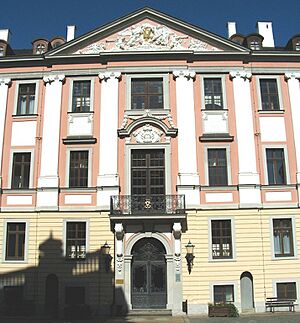Saxe-Altenburg facts for kids
Quick facts for kids
Duchy of Saxe-Altenburg
Herzogtum Sachsen-Altenburg
|
|||||||||
|---|---|---|---|---|---|---|---|---|---|
| 1602 – 1672 1672 – 1825* 1826 – 1918 1918 – 1920† |
|||||||||
|
Anthem: Heil unserm Herzog, heil
(Hail to our Duke, hail!) |
|||||||||

Saxe-Altenburg within the German Empire
 Ernestine duchies after 1825, showing Saxe-Altenburg in orange |
|||||||||
| Status | State of the Holy Roman Empire, State of the German Confederation, State of the North German Confederation, State of the German Empire, State of the Weimar Republic |
||||||||
| Capital | Altenburg | ||||||||
| Government | Principality | ||||||||
| Duke | |||||||||
|
• 1603 – 13
|
Christian II, Elector of Saxony (regent for John Philip) | ||||||||
|
• 1669 – 72
|
John George II, Elector of Saxony (regent for Frederick William III) | ||||||||
|
• 1826 – 34
|
Frederick | ||||||||
| History | |||||||||
|
• Saxe-Weimar partitioned
|
July 7, 1602 1602 | ||||||||
| 1672 – 1825 |
|||||||||
|
• Ernestine duchies
rearranged, duchy restored |
November 12, 1826 |
||||||||
|
• German Revolution
|
November 1918 1918 | ||||||||
|
• Merger of Thuringia‡
|
1920 | ||||||||
| Area | |||||||||
| 1905 | 1,323 km2 (511 sq mi) | ||||||||
| Population | |||||||||
|
• 1905
|
207000 | ||||||||
|
|||||||||
|
* See Saxe-Gotha-Altenburg
† As Free State of Saxe-Altenburg ‡ In 1920, the ex-Imperial states of Saxe-Altenburg, Saxe-Meiningen, Saxe-Coburg-Gotha, Saxe-Weimar-Eisenach, Schwarzburg-Sondershausen, Schwarzburg-Rudolstadt and the two principalities of Reuß all merged to form the free state of Thuringia. |
|||||||||
The Duchy of Saxe-Altenburg (called Sachsen-Altenburg in German) was a small country in what is now Germany. It was one of the Ernestine duchies, which were states ruled by different branches of the House of Wettin.
Saxe-Altenburg was an independent duchy for much of the 1600s. However, in 1672, the last male ruler died. Because only men could inherit the throne in these duchies, Altenburg then became part of the Duchy of Saxe-Gotha. This happened because the Duke of Saxe-Gotha had married the daughter of the last ruler.
In 1825, the ruler of Saxe-Gotha-Altenburg also died without any male heirs. This led to the country being split up. The Gotha part went to the Duke of Saxe-Coburg-Saalfeld. The Altenburg part was given to the Duke of Saxe-Hildburghausen. In return, the Duke of Saxe-Hildburghausen gave up his own lands to the Duke of Saxe-Meiningen. The new ruling family of Saxe-Altenburg stayed in power until 1918. This was when monarchies (countries ruled by kings or dukes) ended in Germany.
After 1918, Saxe-Altenburg became a part of the new state of Thuringia. This happened in 1920, during the time of the Weimar Republic in Germany. In 1905, Saxe-Altenburg covered an area of about 1,323 km2 (510.8 sq mi). It had a population of around 207,000 people. Its capital city was Altenburg. The family line of Saxe-Altenburg officially ended in 1991. This was after the death of Prince George Moritz.
Contents
Dukes of Saxe-Altenburg
These are the rulers who held the title of Duke of Saxe-Altenburg after the duchy was restored in 1826:
- Frederick, Duke of Saxe-Altenburg (1826-1834)
- Joseph, Duke of Saxe-Altenburg (1834-1848)
- Georg, Duke of Saxe-Altenburg (1848-1853)
- Ernst I, Duke of Saxe-Altenburg (1853-1908)
- Ernst II, Duke of Saxe-Altenburg (1908-1918)
Heads of the Ducal House After the Monarchy Ended
Even after the duchy stopped being a country, the family line continued to have a "head of the house."
- Ernst II, Duke of Saxe-Altenburg (1918-1955)
- Georg Moritz, Hereditary Prince of Saxe-Altenburg (1955-1991)
The main Saxe-Altenburg family line ended in 1991. Other related branches of the family still exist. These include the Saxe-Meiningen and Saxe-Coburg-Gotha families.
Related Pages
Images for kids
-
Another view of the Castle of Altenburg
See also
 In Spanish: Ducado de Sajonia-Altemburgo para niños
In Spanish: Ducado de Sajonia-Altemburgo para niños










